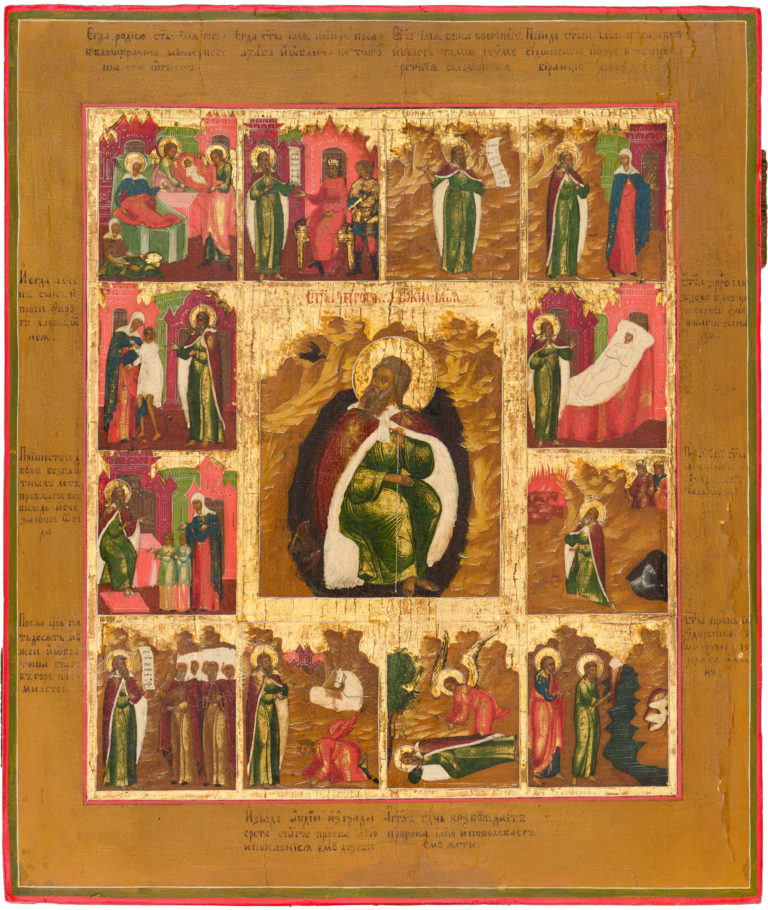The Prophet Elias in the Desert, with 12 Hagiographical Border Scenes
Antique Russian icon. Second quarter – middle of the 19th century. Guslitsy (?).
Size: 31 х 26 х 2.2 cm
Wood (two panels), two incut profiled support boards, a shallow incut centerpiece, underlying layer of canvas is not visible, gesso, tempera.
The author’s paintwork is well preserved with only some chafing and fallouts of paint visible across the surface. There are also restoration tonings on the background and borders of the religious icon.
Contact us

The Prophet Elias in the Desert, with 12 Hagiographical Border Scenes
Diagram of the border scenes:
- The Nativity of the Prophet Elias;
- The Prophet Elias denounces King Ahab;
- The Prophet Elias in the Desert;
- The Prophet Elias comes to the widow at Sarept;
- The Prophet Elias comes to the home of the widow, asking for bread;
- The Prophet Elias raises the widow’s son from the dead;
- The Prophet Elias multiplies the bread in the widow’s home;
- By the prayer of the Prophet Elias, fire comes down on the altar from the Heavens;
- The Prophet Elias calls the priests of Baal to repent on Mount Carmel;
- Avdius leaves his city and, meeting Elias, kneels before him;
- The Angel comes to the Prophet Elias in his dream;
- Prophets Elias and Elisha cross the Jordan.
The given antique Russian icon depicts the Prophet Elias, one of the most revered and venerated Christian saints, who lived in the times of the Israelite Kings Ahab and Ahaziah (9th century BC). The events of his life are described in the Old Testament Book of Kings (3 Kings. 17:1–19; 18; 21:17–28; 4 Kings. 1: 3–17; 2: 1–18); as well as in the apocryphal “Praise to Elias,” hailing from the writings of Pseudo-Dorotheus and Pseudo-Epiphanius. The name of the Prophet is translated as “Yahweh is my Lord,” which reflects his fervent and relentless service to One God. Elias was born in the Galilean town of Tishbe, from which he would later earn his nickname “Thisbite.” The Prophet Elias was held in incredible reverence in Russia. In folk culture, he was seen as the Prophet who could command the forces of nature (namely – thunder and lightning), as well as a healer. At the end of his life, Elias was taken up into the heavens in a fiery chariot, which was traditionally seen as a prophetic witness to Christ’s future Resurrection. A series of his deeds was also seen as the forerunners of Christ’s miracles: the multiplying of bread, the raising from the dead, the walking on waters, the ascension.
Hagiographical hand-painted Orthodox icons of the Prophet Elias are known in Russian icon art since the 13th century. They become especially numerous in the 17th century in the Volga region largely due to the fact that Elias was highly venerated in the merchant cities of Yaroslavl and Kostroma, where churches were built in his name. The centerpiece of the given antique Russian icon depicts the popular Old Testament episode, describing Elias in the desert during a horrible drought when the Prophet was fed by the raven at the Horaf stream (3 Kings. 17:3–7). The image “Prophet Elias in the Desert” is not only seen as the ideal of the hermit and monastic life but also brings to light the Eucharistic theme, since the Prophet was miraculously fed by God through the raven. The large figure of Elias occupies the center of this hand-painted Orthodox icon – the Prophet sits on a rock, before a cave, dressed in a long green tunic and a brown goat’s wool cloak, turning towards the raven. The surrounding hagiographical scenes are traditional in their Eastern Orthodox iconography and execution. The only rare scene included in this piece of beautiful Russian icons of saints is the depiction of Ahab’s courtier, Avdius, who saved over a hundred of God’s prophets from being murdered and fell to his knees before the great Prophet Elias after meeting him.
The artistic traits of the given antique Russian icon, namely its subtle color scheme built on the combination of pale ochres, dimmed browns, reds, pinks, blues, and the highly active greens and whites (that shame the accents), as well as the rather harsh gold hatching, allow us to consider with the highest level of probability that this piece of antique Russian icons of saints was painted in one of the greatest Old Believer iconographic centers in the Moscow region – Guslitsy.